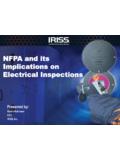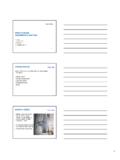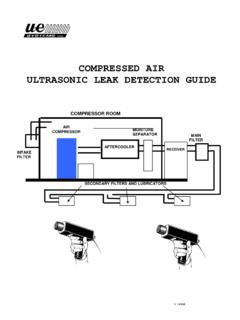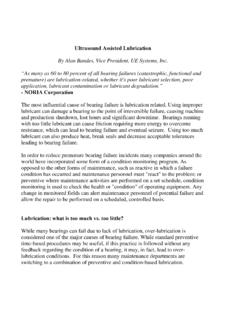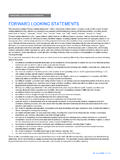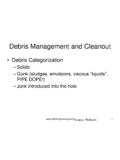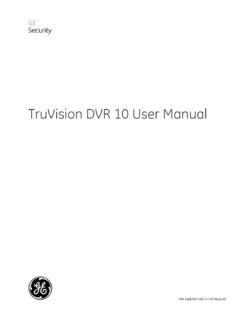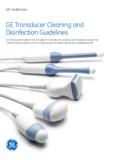Transcription of RELIABILITY BASED MAINTENANCE (RBM) Using …
1 RELIABILITY BASED MAINTENANCE (RBM) Using Key performance Indicators (KPIs) To Drive Proactive MAINTENANCE Robert Ford, CMRP GE Power Generation Services 4200 Wildwood Parkway, Atlanta, GA 30339 USA Abstract - This paper presents the current status and results of a RELIABILITY BASED MAINTENANCE (RBM) program in its fifth year of implementation on a global fleet of 25 power plants. The paper shares the best practices in monitoring fleet MAINTENANCE key performance indicators (KPIs) and how this process guides the MAINTENANCE strategy to take advantage of preventive and predictive MAINTENANCE technologies.
2 INTRODUCTION The challenges for power plant owners to increase RELIABILITY and reduce cost have never been greater. As a result, many organizations are experimenting with numerous initiatives to meet these goals. RELIABILITY BASED MAINTENANCE (RBM) is a proactive approach to helping power plants achieve better results of delivering the highest availability and RELIABILITY at the lowest cost. To achieve this, RBM programs typically focus on reducing the effects of unplanned MAINTENANCE while at the same time managing the level of planned and predictive MAINTENANCE .
3 To build an effective program, current routine preventive MAINTENANCE strategies must be evaluated within the context of a plant s specific layout and operational profile, and then benchmarked against comparative fleet data to determine where the best opportunities exist. Five years ago, the authors organization embarked upon a strategic initiative to develop and adopt a common MAINTENANCE philosophy throughout its fleet. The long term expected benefits of the program were established as follows: Improve safety through better planning Reduce risk to assets that can impact availability and RELIABILITY Extend plant availability and RELIABILITY Perform the right MAINTENANCE on the right equipment BASED on asset criticality Reduce O&M costs by eliminating unnecessary MAINTENANCE and extending MAINTENANCE intervals where possible Reduce/eliminate unplanned equipment failures Standardize the MAINTENANCE strategy across the fleet Reduce MAINTENANCE duration times Measure key performance indicators (KPIs)
4 Through fleet reporting Drive change through active, organization-wide engagement Understand failure modes and timing of events to proactively perform the right MAINTENANCE Improve contingency planning Better utilize advanced monitoring capabilities to continuously track asset performance Once the business committed to developing an RBM program, the first step was to benchmark the fleet s current status, followed by a series of projects designed to identify and quantify best practices. The results of each project were consolidated, memorialized and published into a document entitled O&M MAINTENANCE Playbook, which outlines the requirements necessary for all existing and new facilities to achieve RBM, and includes RELIABILITY BASED MAINTENANCE guidelines intended for consistent implementation across the operating fleet.
5 We are entering the Preventive MAINTENANCE (PM) optimization phase now where we study KPIs and failure data to drive continuous improvement BASED on data to make sound decisions. Learning where to best utilize preventive and predictive MAINTENANCE helps diagnose problems before planned corrective work begins, thus avoiding unplanned repairs. g 2014, General Electric Company, All rights reserved. Page 1 MANAGEMENT ESTABLISHING THE MAINTENANCE VISION AND STRATEGY Experience has shown that a successful RBM program implementation has demonstrated that management engagement, coupled with data standardization and MAINTENANCE standardization, form the foundation on which organizations can build a solid program.
6 The below pyramid highlights the basic building blocks needed to form an effective program. Leadership within the authors organization adopted this vision of RELIABILITY BASED MAINTENANCE : RELIABILITY BASED MAINTENANCE is a method used to ensure plant assets perform as required. Establishing the most economical balance of corrective, preventive, and predictive MAINTENANCE activities to achieve environmental, health and safety compliance and desired plant operability is the overall vision of executing the RBM program throughout the fleet. Top management must also provide the leadership needed to successfully execute the RBM initiative, followed by good communication and training throughout all levels of the organization.
7 STANDARDIZATION OF DATA Standardization of data in the Computerized MAINTENANCE Management System (CMMS) is the first step toward gathering common elements for performance reporting. To complete this, an initial site survey of the 25 plants was made to determine the amount of variation. The study revealed significant variation in the CMMS configuration and data reporting. It was immediately evident that the CMMS was being utilized differently at each location, and standard reports were not available to measure MAINTENANCE performance . MAINTENANCE STANDARDIZATION To learn the MAINTENANCE tasks completed across the fleet, a site survey of the 25 plants was completed to learn what we do from site to site.
8 We learned that we had variation and a common set of MAINTENANCE standards was needed to establish consistency, mitigate risk, improve plant operability and maximize site revenue streams. In order to focus on the most critical plant assets, all 25 plants completed a Failure Modes and Effects Analysis (FMEA), a grading process that ranked equipment by: Process severity, repair time, probability of failure, ability to detect failure, and repair cost. The resulting Risk Priority Numbers g 2014, General Electric Company, All rights reserved. Page 2 (RPN) scores were used to identify which critical assets would become the focus to develop and implement the organization s MAINTENANCE standards.
9 The published guidelines are intended to ensure that all operating sites perform the right activities on the right equipment at the right intervals with some degree of variation allowed, BASED on experience and data. Site MAINTENANCE activities are subject to routine audits to validate compliance and exceptions. MAINTENANCE EXCELLENCE and RELIABILITY BASED MAINTENANCE (RBM) Using Key performance Indicators (KPIs), and how this process guides the MAINTENANCE strategy to take advantage of preventive and predictive MAINTENANCE technologies. Once the initiative was embraced throughout all levels of the organization, the next step was to determine what KPIs offered the best information to achieve the level of direction needed to make the best decisions to ensure plant assets perform as required, and achieve the desired level of availability and RELIABILITY .
10 The organization set a goal of expanding proactive MAINTENANCE and reducing corrective MAINTENANCE or unplanned work at the following levels. Preventive (PM) 42% Predictive (PdM) 42% Corrective (CM) 16% Establishing clear and repeatable data gathering and reporting processes enables an organization to: Create a baseline of current MAINTENANCE performance Evaluate plant performance relative to the fleet Measure improvement outcomes over time This, in turn, allows better cost and resource management by providing a quantifiable look at the percentage of work performed and cost of the work as it relates to proactive and reactive MAINTENANCE .

